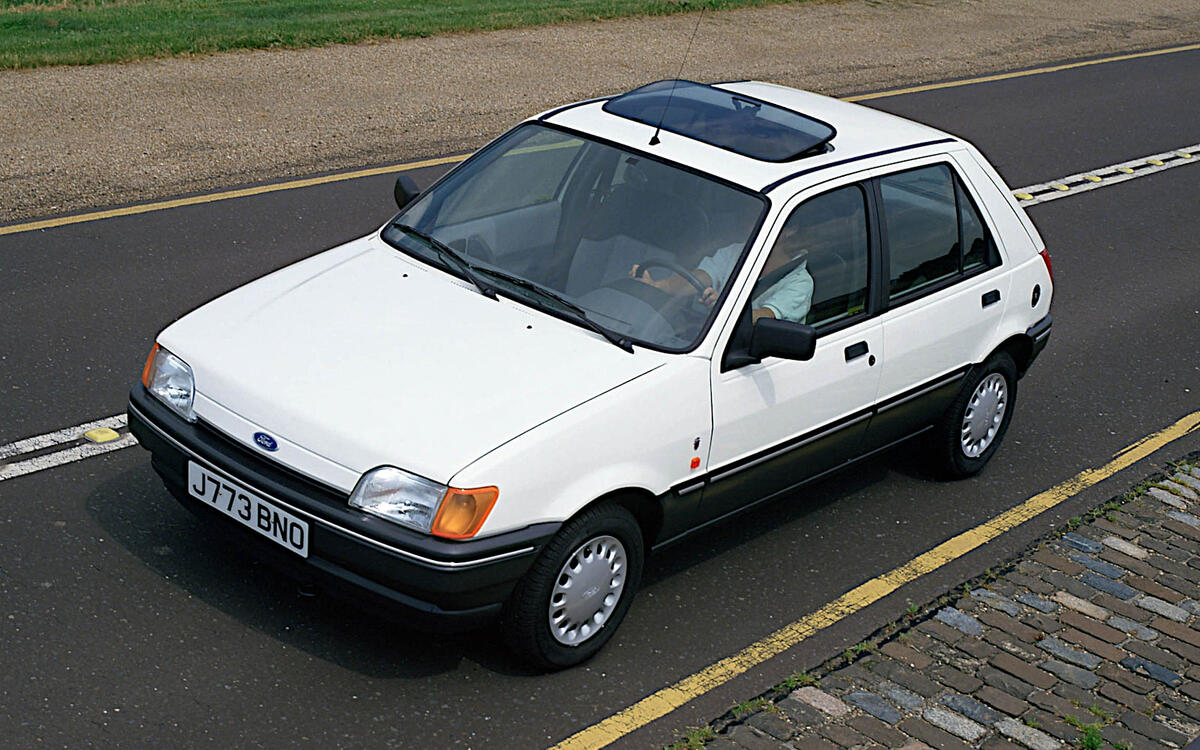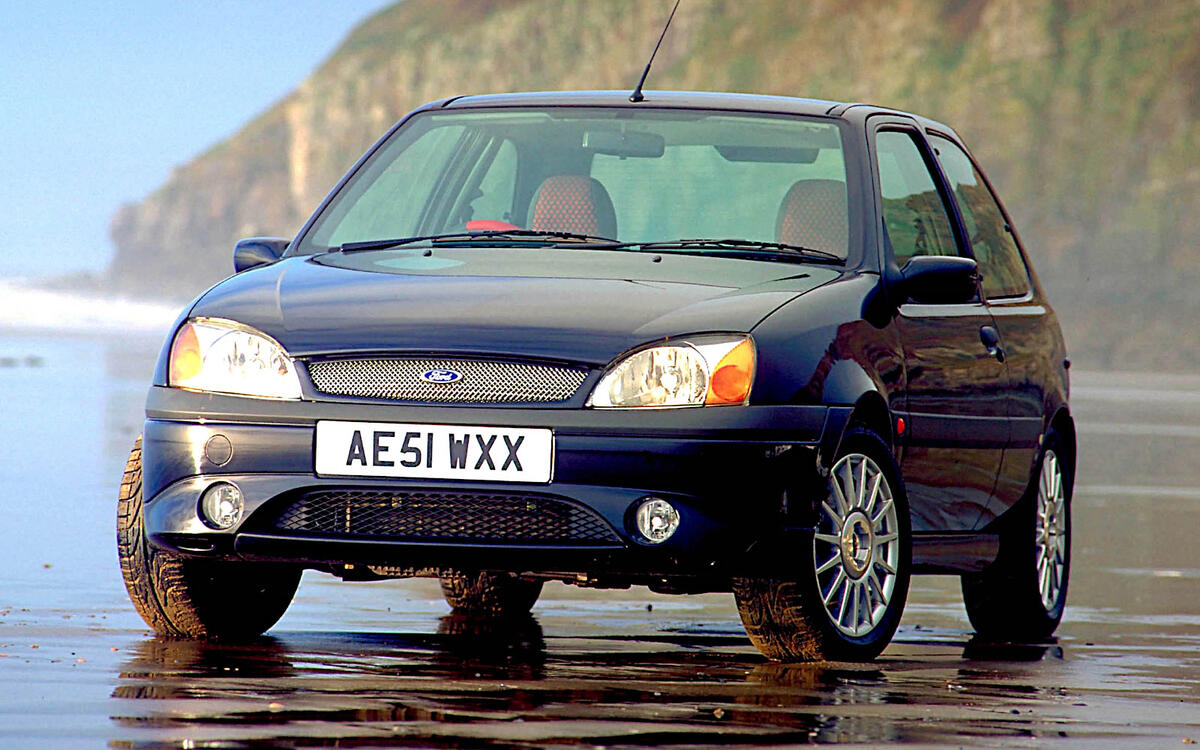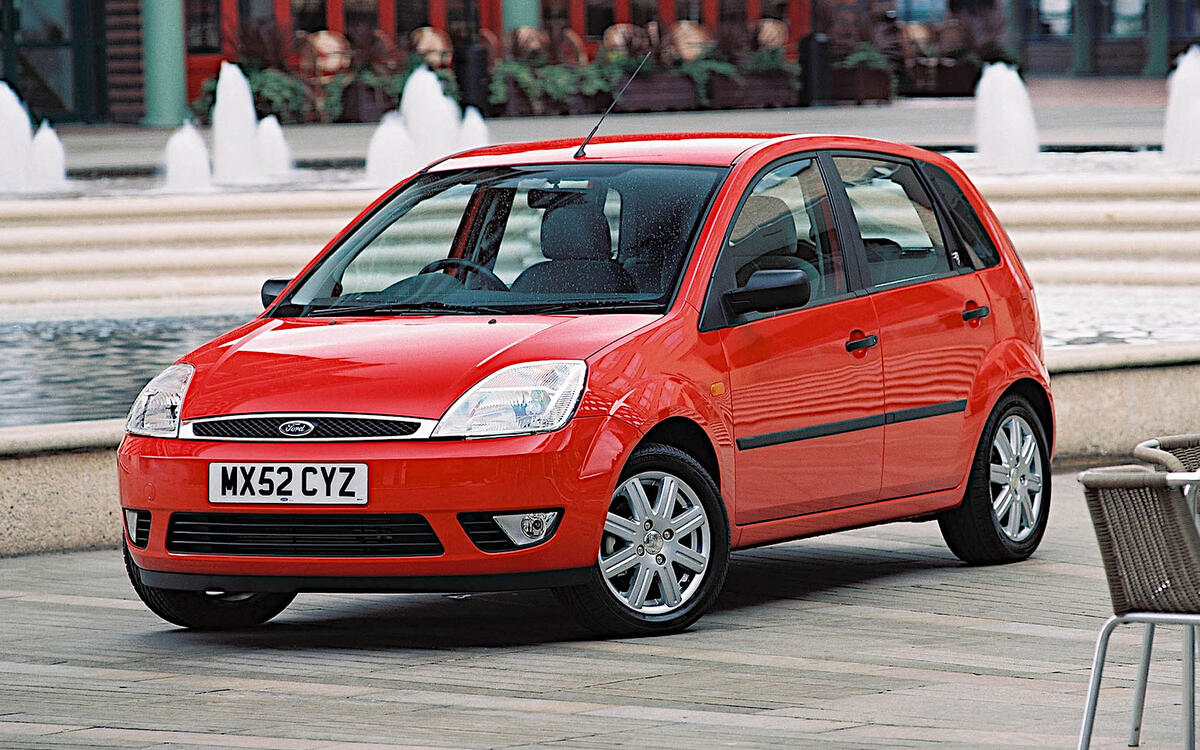 Slide of
Slide of
The Ford Fiesta is no more.
The final examples rolled off the production line in Germany on Friday 7th July 2023. The plant in Cologne is being re-tooled to produce EVs - a sign of the times... It marks the end of an era and a proud model line, and a car where so many of us started our driving lives.
Ford’s supermini was popular from the start, and went on to become the best-selling model in the UK before suddenly falling from grace for one reason or another in the early 2020s. Join us for the full story:
 Slide of
Slide of
Project Bobcat
Within Ford, the Fiesta was known as Bobcat during its early development. Ford came very close to marketing it as the Bravo. ‘Fiesta’ was also considered but then rejected because it was owned by General Motors, which had used it for a station wagon derivative of the Oldsmobile 88 in the 1950s and 1960s. But Henry Ford II persevered, preferring the Fiesta name in part because of its nod to the car’s Spanish production location.
As it turned out, GM didn’t have a problem with Ford taking it on, so Bravo was ditched in favour of the name we know today.
 Slide of
Slide of
A new supermini
The Fiesta was one of Ford’s first front-wheel drive cars, and its first ever model in the B segment, commonly referred to nowadays as superminis.
Small European front-wheel drive hatchbacks were not new (the Renault 5 and Fiat 127, among others, were already on sale when the Fiesta was launched) but Ford helped to popularise the concept, which was taken on by many other manufacturers in the following years.
 Slide of
Slide of
Engines
At its launch in 1976, the Fiesta was powered by engines with the unusual capacities of 957cc and 1117cc. They were both derivatives of the Kent engine, which had first appeared in the Ford Anglia in 1959. Adapted to suit the front-wheel drive layout, they were named Valencia after the city on the Mediterranean coast of Spain where Ford had recently built a new factory
 Slide of
Slide of
The first change
Even the larger 1117cc engine didn’t give the Fiesta much performance, so in an attempt to appeal to more sporty customers Ford created a more powerful 1.3-litre version called the Supersport. This was quickly followed by the hottest Fiesta of the first generation. The XR2 had a 82bhp 1.6-litre engine and looked fantastic, a combination which appealed greatly to younger drivers who liked to go fast.
The XR name implied high performance, though not quite to the same extent as the fabled RS badge, while the 2 indicated that the car was smaller than the Escort XR3. XR4 was used for the high-performance (but pre-Cosworth) derivative of the Ford Sierra
 Slide of
Slide of
The first change
The Fiesta was relaunched in 1983 with a similar body structure but a very different look. Most obviously, it was much rounder, making it more aerodynamic than its sharp-edged predecessor.
There were other benefits. The bonnet line was now taller, allowing the use of overhead-cam engines, and the front-end crumple zone was larger than before.
 Slide of
Slide of
Technical developments
Early Mk2 Fiestas continued to use the Valencia engines, but they also saw the first use (for this nameplate) of the new CVH unit, which had made its debut in the third-generation Escort.
Ford also introduced five-speed gearboxes, a 1.6-litre diesel engine and even a continuously-variable transmission (CVT)
 Slide of
Slide of
The third generation
A third Fiesta was introduced early in 1989. Based on a new platform, it was larger than the previous versions and had much more luggage room, along with larger windows. A five-door body style became available for the first time.
The Valencia and CVH engines were carried over, but in 1992 Ford introduced the new Zetec (originally named Zeta), the first 16-valve unit in the model’s history. Ford also built a small number of prototypes with 1.2-litre three-cylinder two-stroke engines, but did not take the idea into production
 Slide of
Slide of
Top of the charts
Although the Fiesta had always been popular, it wasn’t until 1990 that it became the most-registered car in the UK, according to figures supplied by the Society of Motor Manufacturers and Traders. It held that position for two years before being overtaken by the fifth-generation Escort.
This might have been the largest Fiesta yet, but it was also the smallest car to reach the top of the SMMT list, and the first supermini.
 Slide of
Slide of
Faster Fiestas
From launch, the third Fiesta was available in XR2i form, the ‘i’ denoting that its 1.6-litre CVH engine had fuel injection. The same engine was later turbocharged for the 133bhp RS Turbo (pictured), bringing the Fiesta into the RS orbit for the first time.
The RS Turbo was replaced in 1992 by the RS1800, which had a 1.8-litre version of the fuel-injected Zetec engine producing 130bhp
 Slide of
Slide of
Fourth generation
The Fiesta launched in 1996 was based on an only slightly modified version of the platform used for the previous one, but it looked very different thanks to its very strange – and somewhat controversial – front-end styling. Engines included the new Zetec-SE (also known as Sigma and, later, Duratec), which was available in capacities of 1.25, 1.4 and 1.6 litres.
The same car was also sold as the Mazda 121. Meanwhile, the previous Fiesta was still proving popular, so it remained in production as the Fiesta Classic
 Slide of
Slide of
Facelift
This Fiesta was the only one to receive a major facelift during its production life. Ford applied its New Edge styling in late 1999, at which point the car dropped from its position at the top of the SMMT annual registrations list, where it had been for three years.
However, this was largely due to the introduction of the very impressive Ford Focus. The Fiesta was still an exceptionally popular car in the supermini class.
 Slide of
Slide of
A Fiesta for the new century
The next Fiesta was launched early in 2002. At first, the only body shell available was a five-door, but later that year Ford began offering a three-door alternative with a slightly more coupe-like appearance. A minor facelift was performed in 2005.
There was also a taller, roomier compact MPV derivative known as the Fusion, which had nothing to do with later American Fords of the same name.
 Slide of
Slide of
Fiesta ST and Zetec S
The most powerful Fiesta of this generation was the three-door ST (pictured), which broke all previous records for the nameplate by having a 2.0-litre engine which produced 148bhp.
The styling upgrades applied to this car also appeared on the Zetec S, whose 89bhp 1.6-litre turbodiesel motor made it considerably slower but much cheaper to run.
 Slide of
Slide of
Mass appeal
Even the popularity of previous Fiestas could not prepare anyone for the success of the version which went into production in 2008. In its first full year on sale, it hit the top of the SMMT’s annual registrations list, which was dominated by the Fiesta in every subsequent year until 2020. Due to the global financial crisis, it took a while to exceed the 126,928 registrations achieved by the Focus Mk2 in 2007, but in 2013 it reached 133,434, a figure which is unlikely to be beaten in the near future.
The basis of the new model was Ford’s Global B platform, which has also been used for the B-MAX, EcoSport, Ka, Puma, Transit Courier and the Indian-market Figo.
 Slide of
Slide of
Three cylinders
In 2013, the car became available with a 1.0-litre three-cylinder EcoBoost engine, which had the smallest capacity of anything fitted to a Fiesta since the 957cc Valencia unit.
Also used in a wide variety of other Fords – including even the much larger Mondeo – the EcoBoost took overall and class wins in the International Engine of the Year awards almost every year from 2012 to 2019. In its most extreme form, it produced 138bhp, one of the highest outputs ever seen in a standard Fiesta.
 Slide of
Slide of
The new Fiesta ST
The ST name was revived for yet another Fiesta hot hatch in 2013. Powered by a 1.6-litre four-cylinder EcoBoost engine, it officially produced a maximum of 180bhp, which at first sight put it around 20bhp behind its closest rivals.
In fact, the turbocharged unit had an overboost function which raised power to 197bhp for the first 15 seconds on full throttle. Since you’d be hard pressed to find a road where you could use full throttle for as long as that, this was to all intents and purposes a 200bhp car.
 Slide of
Slide of
Today's Fiesta
The Fiesta moved into its current generation in 2017, though it is still based on the Global B platform.
Lack of interest in superminis led to the car being withdrawn from North America, but it remained on top of the UK market until 2020, when the pandemic caused chip shortages that greatly curbed the number of Fiestas produced.
 Slide of
Slide of
Fiesta Active
There had been derivatives of the Fiesta in the past, but the Courier van and the Fusion mini-MPV had been given their own names. That changed when Ford introduced the Fiesta Active, which could just about be described as a crossover SUV.
In fact, it was still really a supermini, but one with 18mm greater ride height, extra body protection and a driving mode intended to make it more controllable on gravel. We described it as a “halfway-to-crossover”, adding that “halfway-to-halfway-to-SUV” was also an appropriate term.
 Slide of
Slide of
Three-cylinder ST
The fact that all previous Fiesta hot hatches had had four-cylinder engines would once have been considered so obvious as to be not worth mentioning. Ford adopted a new approach when it created one with only three cylinders, and allowing it to run on only two in situations where fuel economy was more important than performance.
Despite having a smaller capacity, the 1.5-litre EcoBoost matched the 197bhp output of the previous ST. We described it as “eyebrow-raisingly fast”, and reported that it felt quicker than the older car “through the middle of the rev range particularly”
 Slide of
Slide of
The fall
After more than a decade at the top of the UK registrations chart, the Fiesta finally fell behind the Vauxhall Corsa in 2021. Despite a facelift in 2022, it is now no longer regularly in the top ten, having fallen behind the Puma as Ford’s most popular model in the country. The final examples rolled off the production line in Germany on Friday 7th July 2023. The final two will be retained for Ford heritage fleets located in the UK and Germany respectively.
If there will be a new entry-level Ford, it will probably turn out to be very different from the current one, and almost certainly the first powered entirely by an electric motor rather than an internal combustion engine, and without the Fiesta name. It's the end of an era, for sure.
Category:
City car
Access control:
Open











































